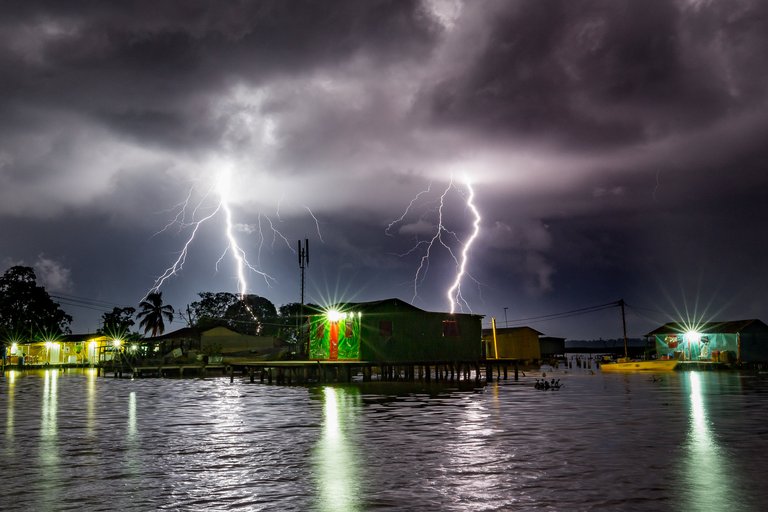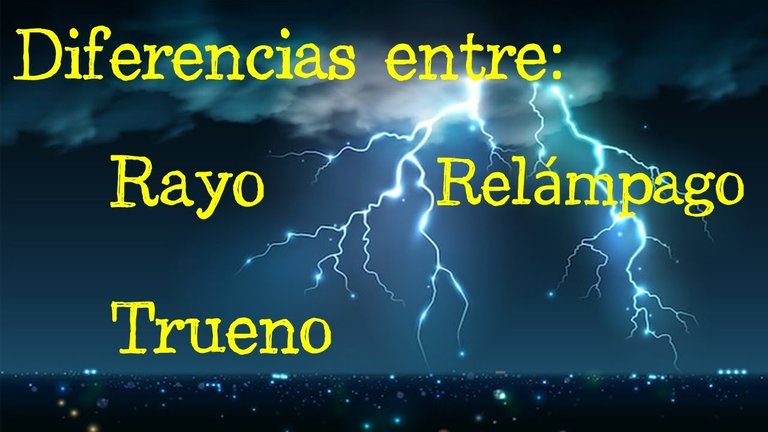¿Cuál es la diferencia entre rayo, trueno y relámpago?/ What is the difference between ray, thunder and lightning?
Versión en español
Cuando ocurre una tormenta en la mayoría de los casos está acompañada de descargas eléctricas, en tiempos antiguos se asociaba este suceso con la ira de los dioses, pero con el avance de la tecnología se ha podido descubrir la verdad tras este fenómeno natural. Las descargas eléctricas están compuestas por rayos, trueno y relámpagos, pero ¿sabes la diferencia entre cada uno? Cabe aclarar que el rayo es el origen del trueno y del relámpago y que usar estos términos como sinónimos a la hora de referirnos a las descargas eléctricas es una práctica muy común pero a su ves errónea.
Rayo
El rayo es una descarga eléctrica que se produce por fricción entre nubes o entre nubes y la Tierra. En ambos casos, debe haber diferencias de voltajes. Cuando estas cargas se atraen se comienzan a formar los rayos. Uno de estos fenómenos puede tener una potencia de 1 gigawatt (mil millones de vatios). El rayo tiene una longitud aproximada de 1.500 metros y el más extenso fue registrado en Texas el año 2001, cuando alcanzó 190 kilómetros. Pueden llegar del cielo a la Tierra a unos a 200.000 km/h. Con la tecnología actual no se ha podido crear una batería que resista la potencia del rayo, pero si en un futuro se logra los problemas de producción eléctrica del planeta serían inexistentes. Un lugar que presenta tormentas eléctricas de forma constante es el lago de Maracaibo, en Venezuela, donde 300 días al año caen rayos de forma continua.

Lago de Maracaibo en Venezuela, conocido como la Capital Mundial del Relámpago. Fuente de imagen
Relámpago
El relámpago es un resplandor que se puede ver cuando hay una descarga eléctrica. A diferencia de los rayos, el relámpago nunca tiene contacto con la Tierra. Cuando ocurre la descarga eléctrica en una tormenta, podemos ver inmediatamente el relámpago y después viene el trueno. Esto se debe a que este destello viaja a la velocidad de la luz (300.000 km/s), la cual es más rápida que la del sonido (340 m/s). Del mismo modo, no se puede hacer cálculo de la distancia a la que estamos del evento, porque la velocidad de la luz es demasiado rápida.
Trueno
El trueno es el sonido que se escucha durante una tormenta eléctrica. Se forma cuando un rayo calienta el aire por el que se mueve a más de 28.000ºC. Este aire caliente se expande a gran velocidad y se junta con el frío del entorno, provocando que baje su temperatura y contraiga. Esta contracción genera ondas de choque y por ello el ruido del trueno. Este ruido es el que causa mayor temor en las personas que padecen de astrafobia o también llamada brontofobia (miedo irracional a ser alcanzado por un trueno). Uno de los métodos conocidos para enfrentar este miedo es el de entender el mecanismo que originan las tormentas y aprender sobre ellas, es un método bastante simple pero entender lo que te da miedo y saber a qué te enfrentas es una buena forma de eliminar los miedos irracionales.
English version
When a storm occurs in most cases it is accompanied by electrical discharges, in ancient times this event was associated with the wrath of the gods, but with the advancement of technology it has been possible to discover the truth behind this natural phenomenon. Electrical discharges are composed of ray, thunder and lightning, but do you know the difference between each one? It should be clarified that ray is the origin of thunder and lightning and that using these terms as synonyms when referring to electrical discharges is a very common practice but at the same time erroneous.
Ray
Ray is an electrical discharge produced by friction between clouds or between clouds and the Earth. In both cases, there must be differences in voltages. When these charges attract, ray begins to form. One of these phenomena can have a power of 1 gigawatt (billion watts). Ray is approximately 1,500 meters long and the longest was recorded in Texas in 2001, when it reached 190 kilometers. They can reach from the sky to the Earth at about 200,000 km/h (124,000 mph). With current technology it has not been possible to create a battery that can withstand the power of ray, but if in the future it is achieved, the problems of electricity production on the planet would be nonexistent. One place that presents constant lightning storms is Lake Maracaibo, in Venezuela, where 300 days a year lightning strikes constantly.

Lake Maracaibo in Venezuela, known as the Lightning Capital of the World. Image source
Lightning
Lightning is a glow that can be seen when there is an electrical discharge. Unlike lightning, lightning never has contact with the Earth. When the electrical discharge occurs in a thunderstorm, we can immediately see the lightning flash and then comes the thunder. This is because this flash travels at the speed of light (300,000 km/s), which is faster than the speed of sound (340 m/s). Similarly, it is not possible to calculate how far we are from the event, because the speed of light is too fast.
Thunder
Thunder is the sound heard during a thunderstorm. It is formed when lightning heats the air through which it moves to more than 28,000°C (82,000°F). This hot air expands at high speed and meets the cold surrounding air, causing it to lower its temperature and contract. This contraction generates shock waves and thus the noise of thunder. This noise is the one that causes the greatest fear in people suffering from astraphobia or also called brontophobia (irrational fear of being hit by thunder). One of the known methods to face this fear is to understand the mechanism that causes thunderstorms and learn about them, it is a quite simple method but understanding what you are afraid of and knowing what you are facing is a good way to eliminate irrational fears.
- Translate by DeepL



Congratulations @ernesto-blguer! You have completed the following achievement on the Hive blockchain And have been rewarded with New badge(s)
Your next target is to reach 1250 upvotes.
Your next target is to reach 50 comments.
You can view your badges on your board and compare yourself to others in the Ranking
If you no longer want to receive notifications, reply to this comment with the word
STOP¡Felicitaciones!
Estás participando para optar a la mención especial que se efectuará el domingo 23 de junio del 2024 a las 8:00 pm (hora de Venezuela), gracias a la cual el autor del artículo seleccionado recibirá la cantidad de 1 HIVE transferida a su cuenta.
¡También has recibido 1 ENTROKEN! El token del PROYECTO ENTROPÍA impulsado por la plataforma Steem-Engine.
1. Invierte en el PROYECTO ENTROPÍA y recibe ganancias semanalmente. Entra aquí para más información.
2. Contáctanos en Discord: https://discord.gg/hkCjFeb
3. Suscríbete a nuestra COMUNIDAD y apoya al trail de @Entropia y así podrás ganar recompensas de curación de forma automática. Entra aquí para más información sobre nuestro trail.
4. Visita nuestro canal de Youtube.
Atentamente
El equipo de curación del PROYECTO ENTROPÍA